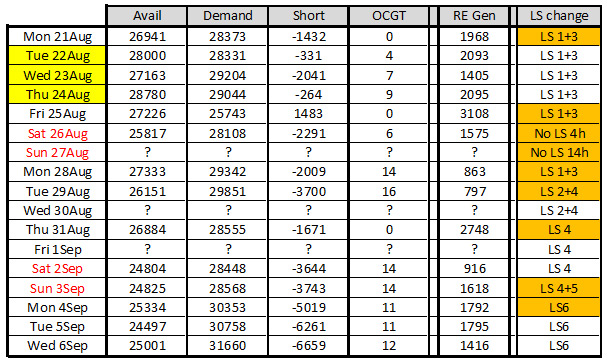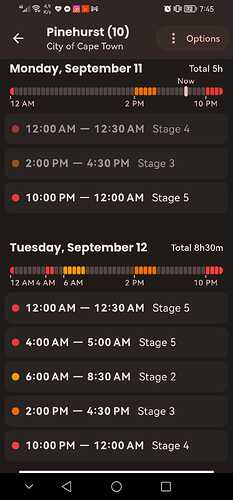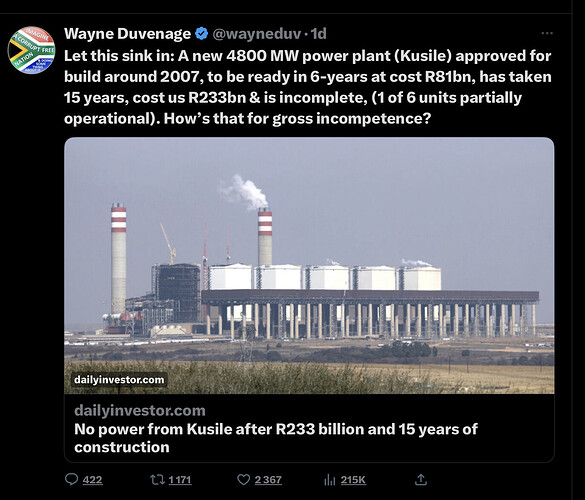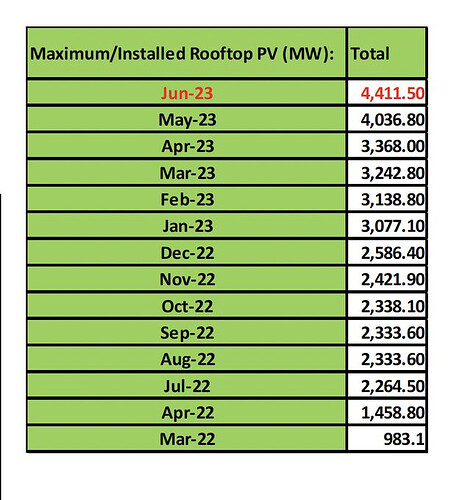All idealistic dreams I have for SA … one day.
The only place where Eskom might have done BRICS a specific favour is delaying planned maintenance but looking at the status reports seems unlikely (but possible). Based on the published numbers OCGT use was not higher during brics compared to the following weeks.

In terms of the increased load from beginning week of 4 September I suspect it might be influenced by TOU rates changing to low demand season from 1 September, so big industrial users might have upped their use again.
Eskom claims to be doing maintenance - even some extra over weekends. Looking at the availability drop on Saturdays vs Fridays, it seems they might be.
EAF compared to 2022 is lower and unplanned outages up… by a magnitude that will be explained by the absence of Koeberg and Kusile - so the 2023 performance is not really worse than 2022.
Since it is Friday and not Donderdag… at least some have a less moody outlook…
Moody’s said its stable outlook reflects its expectation that the debt relief will provide Eskom with time and financial flexibility to improve operational performance.
“The stable outlook also reflects the stable outlook on the Government of South Africa,” it said.
and at least court action to further delay and add to all the other issues around grid availability seems to be put aside
Mark Tanton, the business lead for Necom on transmission, said that Eskom had engaged pragmatically with the industry “in the interests of the country” to find a solution that worked for both parties.
From Battle for access article …
Now THAT is what I want to hear/read … but I’m not voting for them yet …
You know what, grid reliability is a funny thing. Think of it this way, life, industry and manufacturing and production is reliant on a grid that is reliable. If the grid is 99% reliable, we lost only 1% of reliability or put differently we lost -3.65 days of the year we could not do production.
But with rolling blackouts, it’s way worse than that. Lets look at a factory processing milk and manufactures milk based products like cheese or yogurt. When a line goes down for the lack of power, the product on the line is lost. But now, all the time to dump the product because of potential contamination and spoilage, then the time to clean up the line and normally this can only happen when there is power.
Now increase the loss of reliability to say 5%. With the schedules in production time every day, the real loss of reliability from the consumers point of view, is far far worse than the 5% grid reliability loss. At some point, with rolling blackouts, the grid reliability loss of a few % points, translates into the closure of business.
Energy, cheaply and reliably available, is everything. Energy poverty is created in part by a unreliable grid, and mostly by an expensive one. The lower the income for a household, the higher the % spent on energy, of any type, be that electricity or paraffin or petrol.
EffektiweenbetroubaareGroetnis
Imagine you are running a smelter, like in Richardsbay. Now imagine at the cost and interruptions of energy, how long will the business be prepared to continue?
This is de-industrialisation and how it happens. This is how people become energy poor, and how quality of life goes backwards.
Groetnis
Eskom sending homeowners texts not to use their inverters - htxt
In recent days, text messages have been sent to homeowners with inverters asking them not to charge said backup power solutions during peak loadshedding hours.
The texts reportedly come from Eskom, although the power utility has not officially made mention of issuing such communications with South African homeowners at the time of writing.
The message, featured below too, asks homeowners to only charge their inverters between 22:00 in the evening and 05:00 in the morning.
“Dear Customers, the system is constrained due to high demand. We plead with you to charge your inverters only between 22:00-05:00,” the text shared with Hypertext outlines.
Haven’t seen it yet, but I get my grid-eletricity through Tswhane.
“Luckily I don’t charge my inverter - just my battery so I’m safe…”
Seriously shows how disconnected the comms of Eskom is to the technical side of things…
And I’d like to use the sun to do this thank you very much. The time slot does not suit me at all.
This is how you change a lightbulb, Ramokgopa says …
But he does not know how LS schedules work … no-one does.
What a joke …
Posted this before … here we went again … we are being hammered with confusion about what level we are at to hide higher levels of LS …
From here:
Why, haven’t you noticed yet that EScam is just that, a scam as is their political and criminal masters it appears. A bunch of morons thinking they know how this works, then lying to attempt to hide reality and their own incompetence.
Wonderful how they plead not to charge batteries, when if they did their work in the first place, there would be 0 need to charge em in the first place… Why a circus, we just missing the music…
ClownGroetnis
Yeah… funny you bring up that article. My phone has this thing where it automatically finds me news articles I might like. So I’m cleaning out notifications and I see the “Stage 7” headline. And so I say to my wife… I wonder if that was a real actual stage 7, or the usual “they shed more than 6000MW so technically it was stage 7” drivel. Well, you see my pessimism was rewarded, because it was the latter, and it was from the media house I now equate with this kind of nonsense.
on the battery charging notice thing, while assuming it is from Eskom (muni’s might have more reason to request not charging during peak than Eskom does) and despite the less than stellar technical phrasing of the notice - some folks at SUN crunched some numbers and concluded:
… that with a mere 15% penetration, the intended effect of load shedding will be curtailed by just over 60% in summer and just over 70% in winter … the impact of allowing users to charge at 0.5 C (half the battery capacity equivalent), without solar augmentation, will have a dramatic impact on the domestic load, even with only 15% penetration. It is therefore imperative that charging batteries from the grid is restricted to protect the potency of load shedding as a grid-balancing tool.
Thank snot … I see they “fixed it” …
Today we now have Stage 5 then 4 then 6 … it is better than wot 6, 5, 2, 1, 4, 3, 5, 6, 1 …
Starting tomorrow we have Stage 6, like in 6, 6, 6, 6, followed by 666 on Thursday.
But here’s the thing now … they smoking us with the hours … is it 2.5h or 4.5h per stage 6 … all in the small print see.
![]()
I think I know what you need to do. Since CoCT is so bad at sticking to one stage, you may have to do it for them. Get a timer switch and set it to the stage 6 times. Done.
![]()
CoCT is a victim here too … if they had their way there would be no LS.
![]()
Who did not see this this morning?
I wonder how much more big industry can take …
And private and business did it at no cost to the state in around 18 months (ref)
Jip … but some big industries cannot take it all up with renewables …
Makes me wonder … how long before private and business hits the 30,000MW level, to “compete” with Eskom?
If Kusile was "replaced’ in a year … can it be done in wot, 6 years, generating 30,000 from renewables done outside of Gov, at the existing stats … or maybe in 3-4 years if SA goes “bos”?
The ONLY challenge then is what to do at night … the endless debate … am aware that massive batteries are being considered, some are installed, need more dams, powering an entire country at night … tough one.
Wonder how Cpt will handle it … offshore wind farms eventually?




